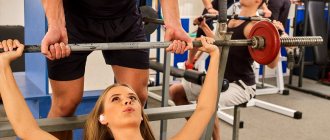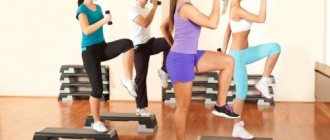The right start to the day: morning exercises for men
Morning exercises for men are a set of sports activities, the implementation of which gives a boost of energy, provides an excellent mood for the whole day, helps to wake up faster and get involved in work.
Morning exercises are an essential element of a healthy lifestyle and the prevention of various diseases. Regular training at home stabilizes the autonomic system, improves blood flow, reduces the risk of obesity, helps strengthen the muscle corset, and has a positive effect on a man’s sexual activity. The classes are accessible to absolutely everyone, as they do not require equipped premises or special equipment. Doing exercises at home allows you to save time and money on visiting sports complexes.
Training result
Morning exercises for men allow you to stay in good shape and not gain extra pounds even in adulthood. There are other benefits of daily exercise:
- allow you to strengthen the muscle corset;
- maintain correct posture and alignment of the vertebrae;
- reduce the risk of various diseases, including pathologies of the cardiovascular system and hernia formation;
- improve performance, improve mood;
- make the figure fit and sculpted;
- During exercise, blood flow improves and the risk of venous disease is reduced.
In addition, effective morning exercises for men make muscle tissue and joints more elastic, and also help the body get ready for work. After training, it is recommended to take a contrast shower, of course, if there are no contraindications. All these activities enhance the effect obtained from physical activity on the body and internal organs.
Where to begin
Exercise will bring health benefits if you take morning exercises seriously and adopt a few basic rules:
- Develop a set of exercises for the morning. In this case, it is necessary to take into account the individual characteristics of the body.
- Give the body time to adapt. 7-14 days will be enough to get used to the new daily routine. It is better to set the alarm clock half an hour earlier. This will allow you to study at a calm pace, without being distracted by thoughts of lack of time.
- Do not start exercise immediately after waking up. During sleep, metabolic processes in the body slow down, the volume of circulating blood decreases, and the rate of heartbeat decreases. You need to help your body wake up. To do this, while lying in bed, you can take several deep breaths and exhalations, stretch, and massage your hands and feet.
- Do exercises regularly. Over time, morning exercises will become a useful habit.
- If possible, exercise outdoors. If training takes place at home, you need to open the window and ventilate the room. The room should not be too cold or hot.
- Perform exercises in comfortable clothes that do not restrict movement.
- Gradually increase the intensity of your training.
- Alternate exercises for different muscle groups. Classes won't be boring if you develop several complexes.
Expert advice
Any physical exercise, including morning exercises, is performed taking into account a number of features. Experts advise adhering to the following rules:
Before sporting events, you can perform morning water procedures (washing and brushing your teeth), but eating breakfast is strictly prohibited. This is due to the fact that fat reserves are consumed much faster on an empty stomach, and the manipulations themselves are easier to perform.- It is best to exercise in the fresh air; a street or even an open balcony is ideal for this. You can practice at home, you just need to ventilate the room first.
- During exercise, the body should not become overcooled or overheated.
- For charging, it is better to choose convenient and comfortable clothes designed for sports and that do not restrict movement.
- During sporting events, it is extremely important to monitor your breathing. You need to breathe evenly and through your nose, exhale when making efforts, and inhale when relaxing.
- The first complex consists of light gymnastic movements. After them, they begin power loads.
Basic complex of morning exercises
The morning exercise program is developed taking into account the physiological capabilities, level of sports training, as well as the age of the man.
A gentle set of exercises is recommended for older men who have not previously engaged in sports. After 40 years, metabolic processes slow down, the risk of developing cardiovascular diseases increases, and the body’s protective functions weaken. Intense exercise can cause deterioration in health.
During the period of adaptation of the body to physical activity, it is necessary to perform morning exercises for 10-20 minutes; you can gradually increase the time to 20-30 minutes. It is important to apply the principle of load dissipation, that is, to consistently involve different muscle groups in the work.
Morning exercises are a set of exercises that include a warm-up, the main block of exercises and the final stage of the workout.
Warm-up exercises include:
- head tilts;
- rotation of the brushes;
- circular movements of the shoulder joints;
- body bends;
- swinging movements of the arms;
- rotation of the pelvis;
- circular movements of the feet.
All exercises from the warm-up complex are performed calmly. Breathing is done through the nose. The number of repetitions does not exceed 15-20 times. Light exercises will help warm up the body and allow a smooth transition to the main complex.
The main block of morning exercises for men includes:
- Squats (3 sets of 15 repetitions). The exercise engages the muscles of the legs, lower back, upper back and abdominals. Starting position: standing, feet shoulder-width apart. You need to squat so that your pelvis is below your knees and your back remains straight. The heels should not leave the floor.
- Push-ups (2 sets of 20 repetitions). Starting position - lying down. It is necessary to bend your elbows, your torso should be parallel to the floor, then, straining your body, slowly straighten your arms and return to the starting position. The back and legs should be in one line.
- Lateral lunges (2-3 sets of 15 repetitions). Feet should be placed as wide as possible, arms extended forward. The back should be straight. Squats are performed alternately on one leg and then on the other. The toe of the straightened leg should point upward.
- Classic lunges (2-3 sets of 15 repetitions). Starting position: standing, feet shoulder-width apart. Alternately, the legs are put forward. The back is straight, the stomach is pulled in.
- Leg raises (2-3 sets of 10 times). Starting position: lying on your back. As you exhale, both legs rise; as you inhale, they return to their original position.
- Crunches (3-4 sets of 10 repetitions) are a classic abdominal exercise. Performed while lying on your back. Hands are under the neck. Legs are bent at the knees, feet pressed against the wall. As you exhale, bend your back so that your shoulders lift off the floor. In this case, the lower back should press harder to the floor. As you inhale, you need to return to the starting position.
- “Plank” (2 sets of 1 minute) is an exercise that engages the muscles of the abdominals, back, buttocks and thighs. You need to rest your palms or elbows on the floor (a more difficult option). The toes also touch the floor. The body should form a straight line from the pelvis to the crown of the head.
An excellent end to your morning exercises would be a run in pleasant sunny weather.
The best programs for any age at home
You need to select morning exercises taking into account the health status and age of the man. For example, jumping rope is not suitable for people suffering from musculoskeletal diseases and heart problems. Men with chronic pathologies should consult a doctor before performing exercises.
Up to 30 years old
The complex for men under 30 years of age should include the basic exercises presented earlier. They are considered as preparation for other types of exercises, which are more complex in technique and require certain strength expenditures.
The list of additional loads for young people includes:
- Plank. During the training, the body weight is transferred to the elbows and feet. Stay in this position for 1-1.5 minutes. For trained men, you can complicate the exercise, for example, lean on your hands and one foot or on your feet and one hand.
- Pull-ups on the bar with wide arms. Pull-ups will strengthen the muscles of the upper body and make your figure more prominent. Perform 5 pull-ups at a time for 3 repetitions
- Leg lunges with weights. The number of repetitions is 35 times for each leg.
- Push-ups – 10 times in 2 sets. As you prepare, the exercise also becomes more difficult.
If a young man is in good physical shape, then a basic set of exercises (side and forward bends, squats, crunches) can be performed using dumbbells or water bottles as a weighting agent.
Up to 40 years old
Men under 40 years of age can also adhere to the basic, previously presented complex. However, at this age you need to be more careful with weights. People with poor physical fitness should not use dumbbells at first.
You can add to the list of additional exercises included in the complex:
- Walking in place with simultaneous rotation of the hands (1 minute).
- Squats with shaking the hands or moving the arms to the side (6-10 times in 3 repetitions).
- Run in place with your knees pulled back. The training starts with 15-20 seconds. Gradually increasing the exercise time to 2 minutes.
Basic exercises for men under 40 years of age can be done at a higher pace. This will help to work out various muscle groups and lose excess weight in problem areas.
50-60 years
After 50 years of age, men should stop exercising at a fast pace, as this can lead to injury and heart problems. At this age, it is allowed to use the basic complex, but all movements in it are done with a small amplitude in a slow mode.
Morning exercises for men 50-60 years old include the following set of exercises:
- Walking in place with arms raised as you inhale and lowered as you exhale (1 minute).
- Half-bends with your head slightly raised and your arms out to the side. The torso is placed parallel to the floor and slightly bent at the lower back. Number of repetitions 6-8 times.
- Springy bends forward as you inhale and straighten your body as you exhale. During the warm-up, your feet should be shoulder-width apart.
- Alternating jumps in place with landing on the pushing leg – 10-12 seconds
Important! Exercises for older men differ from the complex for young men in that basically all the exercises in it are done in 1 approach. That is, the execution time of the complex itself is reduced. Pay more attention to breathing during warm-up. After warming up, it is advisable to walk in place until your heart rate is completely restored.
After 60 years
For persons over 60 years of age, the basic complex is partially suitable. At this age, it is allowed to rotate the head, hands, torso and pelvis. It is better to abandon classic squats and replace them with a half-squat with your feet shoulder-width apart.
In old age, men especially benefit from breathing exercises, which include coordination exercises:
- walking in a straight line with your eyes closed;
- stand on one leg;
- body tilts to the right and left while kneeling.
A useful exercise after 60 years is raising your arms with alternating inhalations and exhalations. When raising the upper limbs, take a deep breath, when lowering, exhale.
Dumbbell gymnastics
Particular attention should be paid to the dumbbell gymnastics complex for men over 40 years old. With age, testosterone production decreases, which entails a decrease in muscle tone and rapid weight gain. Morning exercises for older men are aimed at normalizing hormonal levels and strengthening overall health.
Before performing exercises with dumbbells, you need to do a warm-up.
The main block of dumbbell gymnastics includes:
- Squats with dumbbells on the shoulders. 5 sets of 10-12 repetitions.
- Lunges with dumbbells. 3 sets of 5-10 repetitions in different directions.
- Side bends. 4 sets of 5-10 repetitions.
- Calf raises. 3 sets of 10-15 repetitions.
- Bent-over dumbbell row. 3 sets of 5-10 repetitions.
- Chest press. 4 sets of 5-10 repetitions.
- Bent over dumbbell swings to the sides. 3 sets of 10-12 repetitions.
Gymnastics after 40 years for men
There is a category of veterans in sports. It varies in different sports, but most often it begins at the age of 40, and after 35 years they are no longer accepted into the army under a contract.
This means that a person at 40 can no longer compete on equal terms with twenty-year-olds.
I have respect for people who, at 40 years old, bench press 200 kilograms or run 200 kilometers, but the issue of training in adulthood is not a matter of development from childhood, but a matter of the body adapting to changes.
At 40 years old it is difficult to turn a triathlete into a triathlete.
Training after 40 years should be divided into two types: with experience and without experience.
If a master of sports returns to training at the age of 40, then this is one topic of conversation; if the librarian decided to go to the start or platform, then another.
Bowling
Photo: shutterstock.com
Yes, bowling is a game of bowls, which we are all used to seeing only as a way to pass the time, knocking down pins and sipping some low-alcohol drink while waiting for our turn. While we brighten up our leisure time with the help of bowling, the entire progressive world is setting records and winning championship titles in this sport. On the planet as a whole, bowling has become such a popular sport that in the near future it will be considered as one of the main contenders for inclusion in the program of the 2020 Olympic Games in Japan. It's never too late to start bowling. Some minimum physical training, of course, must be present, but the main thing in the game is to accurately hit ten pins so that they all fall after the first throw of the ball. This skill can be trained at any age.
Workouts for beginners after 40 years
According to statistics, forty-year-olds have more diseases than twenty-year-olds. The range and quality of diseases indicates the remaining health resources.
For example, sometimes people with one torn ligament in their knee come to me with a request to strengthen their knee. Unfortunately, these people don't understand that squats will not grow a ligament.
It's hard to compete with one link against those who have two.
At age 20, there is a lot of testosterone and young males and females demonstrate their dominance in competitions. At 40 years old there is little testosterone and “ligaments”, so demonstrating dominance: there is less desire and more dangers.
Motivation to exercise at 20 years old and at 40 years old are different motivations. But to start, you need motivation.
People with training and competition experience live on memories and feed their motivation from those memories.
It’s more difficult to start training at 40 years old, because you, a person with a lot of life experience, become a beginner.
I think that at the age of 40 you need to start not with registering for Ironman or Olympia, but with 90 minutes a week of training according to desire and well-being. And then the principle “appetite comes with eating” will do its job itself.
Many of my clients, in order not to overload the body, start with a truncated version of the Size/Quarter technique
Strength training for men after 40
Strength training after 40 is not much different from strength training before 20, except for the results.
Strength gains before age 20 are three times faster than after age 40.
If it takes a year of training to achieve the third category standard at 16 years old, then after forty years - three years.
Taking into account the rate of increase in strength indicators, it is necessary to draw up training plans.
If at 16 years old the training plan gave a 10% increase in strength per week, then this is an excellent result. For someone new to strength training after age 40, a great gain is 3% per week.
At 16 years old, increasing your bench press from 50 to 100 kilograms in a year is the norm. After forty years, the same result is achieved in 3 years.
At the age of 16, a young man can do 150 approaches per week. After forty years, in the first year of training, exceeding the norm of 75 approaches can cause under-recovery.
At the age of 16, a young man can train more than 20% of his training volume at an intensity of more than 90%. After the age of forty, increasing intensity above 80% can cause injury. This means that working approaches should be performed for at least 4 repetitions according to the principles of half-strength and “minus one”
Simple conclusions: after forty years of strength training, it is better to start with 75 approaches, with an intensity of up to 80% and a growth rate of up to 3% per week.
Create a strength training program
Cardio training for men over 40
Men over 40 who decide to start cardio training need to be attentive to their pulse and joints.
Children can afford to play catch without a heart rate monitor and tear their knees on the asphalt. But after forty years it is better not to do this.
A monitor for two thousand rubles is an important attribute for a man after forty, like, for example, a good watch or shiny shoes.
A mature man needs a monitor in order to monitor his heart rate during training and slow down when the upper limit is exceeded, even if a woman who is 20 years younger is running past.
The second issue with cardio training for men after 40 is the musculoskeletal system.
Children learn to walk first, then run, and all this happens naturally.
After 30 years of a sedentary lifestyle, the body can still walk, although some have pain in the knees or lower back, but running can be not only painful, but also dangerous.
You should not choose situational types of cardio training, such as football, if you have not played catch-up for a long time.
Start with your usual walking, but not at a walking pace, as in the office or supermarket, but at a brisk pace, so that your heart rate rises to 170 minus your age.
If your heart rate does not rise from walking, you can switch to jogging at walking speed.
Recovery after training for men over 40
All recovery processes occur during sleep.
Anything that interferes with sleep, shortens it and worsens its quality, interferes with the results of your training.
If training improves your sleep, then you are training correctly.
If food improves your sleep, then you are eating right.
The sleep norm for teenagers is 10 hours a day, for adults 7.
Of course, if a teenager gets 70 hours of sleep a week and an adult gets 49, then the teenager's recovery is at least 30% better.
But the relationship between recovery and sleep percentage is not linear. In fact, 30% of extra sleep gives three times more results in training: what a teenager achieves in a year, a man over 40 achieves in three.
To prevent a man’s sleep from being disturbed after 40 years, training should not be too hard and the diet should not be too strict.
You need to train to gain strength, and not to emasculate them.
The formula “the more the merrier” is true if there is a dream in this formula. The more training and the more sleep, the better the result.
Men who concentrate their courage and will only on training, losing sight of sleep, are not working to gain strength, but to emasculate them.
If for some reason you are forced to limit your sleep, you will have to slow down as your training loads increase.
Without enough sleep, you can no longer count on a 3% increase in training results.
In difficult periods of life, when you cannot sleep properly and train to gain strength, you do not need to maintain your norm in loads and train to emasculate, but you need to switch to the mode of maintaining shape.
Usually this is about 50-70% of your usual training norm during good periods of life, for example, on vacation.
You use your vacation to gain strength, and not to take a break from training?!
Create a strength training program
Shooting
Photo: Shutterstock.com
Like many other sports, shooting requires basic physical training. But this in no way limits the age of the athlete. This is especially true for such shooting disciplines as trap and skeet, in which shooting is carried out from smooth-bore rifles at plates fired into the air. For example, at the last Olympic Games in 2012, bronze medals were won by three veterans of the sports movement, among whom was the Qatari racer, the winner of two Dakar rallies Nasser Al-Attiyah, and even our compatriot Vasily Mosin . The first one turns 45 this year, the second one is already 43 years old.
Training program for men after 40 years
Usually a training program is written for a week based on time and effort.
If you haven't exercised for many weeks, then write a training program for 90 minutes per week.
If last week you completed 7 hours of training and you still have time and energy, then write a training program according to the 10% rule - for 7.5 hours.
Although, most likely, the person who completed 7 hours of training does not need advice on the Internet










